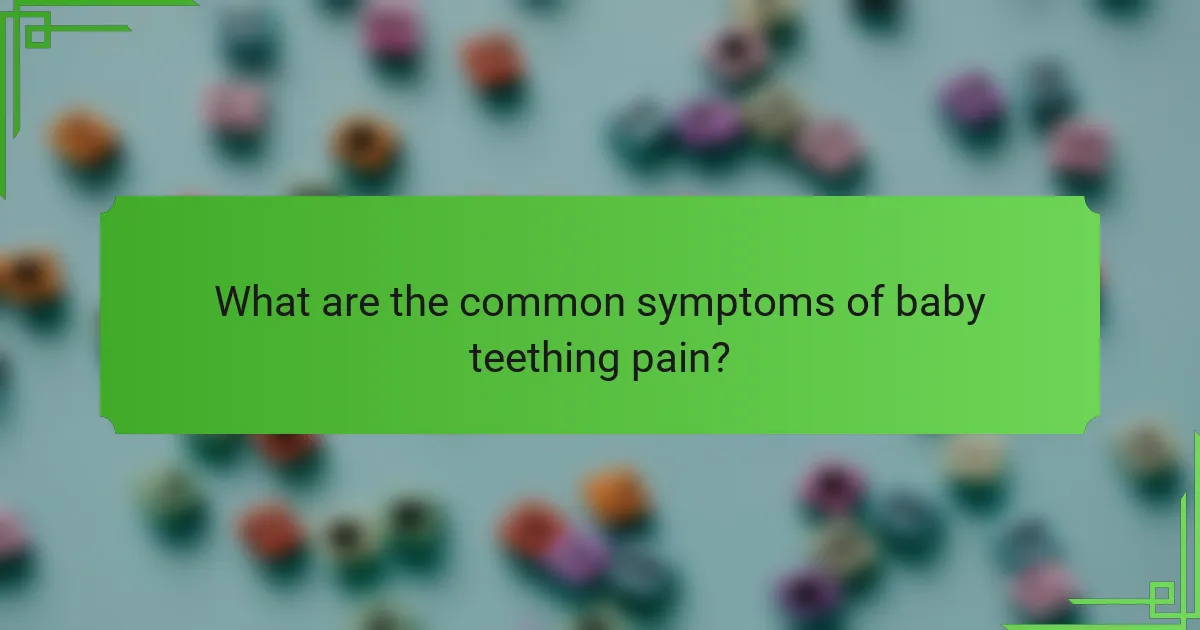Teething pain in infants is characterized by symptoms such as increased fussiness, drooling, swollen gums, mild irritability, and sleep disturbances. Approximately 75% of infants experience discomfort during this developmental phase, which can also include a slight fever. To manage teething pain, parents can employ various strategies including the use of cold teething rings, gentle gum massage, and offering soft, cold foods. Over-the-counter pain relief medications, like acetaminophen, may also be appropriate after consulting a pediatrician. Maintaining a calm environment and using comforting techniques can further help alleviate a baby’s distress during this challenging time.

What are the common symptoms of baby teething pain?
Common symptoms of baby teething pain include increased fussiness, drooling, and a desire to chew on objects. Babies may also experience swollen gums and mild irritability. Sleep disturbances are frequent, as discomfort can disrupt their rest. Some infants may develop a slight fever during teething. These symptoms typically arise as teeth begin to break through the gums. Research indicates that around 75% of infants show signs of discomfort during this developmental stage.
How can parents identify when their baby is teething?
Parents can identify when their baby is teething by observing specific signs and symptoms. Common indicators include increased drooling, which occurs as the body prepares for tooth emergence. Babies may also exhibit irritability and fussiness due to discomfort. Chewing on objects or fingers is another behavior frequently seen during teething. Swollen or tender gums may be noticeable when parents examine their baby’s mouth. Additionally, some babies experience a slight increase in temperature, although it should not exceed 100.4°F. Changes in eating or sleeping patterns can also signal teething. These signs typically appear a few days before a tooth breaks through the gum.
What physical signs indicate teething discomfort?
Physical signs that indicate teething discomfort include increased drooling, irritability, and swollen gums. Babies may also exhibit a loss of appetite or difficulty sleeping. They might chew on objects or their fingers excessively. Additionally, some infants may develop a mild rash around the mouth due to drool. These symptoms typically occur as teeth begin to push through the gums. Studies show that these signs are common during the teething process, confirming their association with teething discomfort.
How does teething affect a baby’s behavior?
Teething affects a baby’s behavior by causing increased irritability and discomfort. Babies may become fussy and cry more than usual during this period. They often exhibit changes in sleep patterns, experiencing difficulty falling or staying asleep. Increased drooling is another common behavior associated with teething. Babies may also chew on objects or their fingers to relieve gum pressure. Some may show a decreased appetite due to sore gums. These behavioral changes typically occur as teeth begin to emerge through the gums. Research indicates that these symptoms can last for several days or weeks, depending on the individual baby and the number of teeth coming in.
Why is it important to manage teething pain effectively?
Managing teething pain effectively is crucial for the well-being of infants. Effective pain management helps alleviate discomfort that can lead to irritability and distress. When teething pain is not addressed, it can disrupt sleep patterns and feeding habits. This disruption may result in inadequate nutrition and poor growth. Research indicates that effective pain relief can enhance a baby’s overall mood and promote better interactions with caregivers. According to the American Academy of Pediatrics, managing teething pain can minimize the risk of behavioral issues associated with prolonged discomfort. Therefore, timely intervention is essential for supporting both physical and emotional development during this critical period.
What are the potential impacts of untreated teething pain?
Untreated teething pain can lead to several negative impacts on a baby’s health and well-being. It may cause persistent irritability and distress, affecting the baby’s mood and behavior. Sleep disturbances are common, as the pain may prevent the baby from sleeping soundly. This lack of sleep can further lead to fatigue and increased fussiness during the day.
Additionally, untreated teething pain can result in feeding issues. Babies may refuse to eat or drink due to discomfort, which can affect their nutrition and hydration. In some cases, prolonged pain may lead to gastrointestinal upset, including diarrhea.
Moreover, untreated teething pain can increase the risk of developing oral health issues. Continuous discomfort may lead to poor oral hygiene practices, as babies might resist tooth brushing. This can result in dental problems later in life.
Overall, addressing teething pain is crucial to prevent these potential impacts on a baby’s health.
How can effective pain management improve a baby’s overall well-being?
Effective pain management can significantly enhance a baby’s overall well-being. When a baby experiences pain, it can lead to distress and irritability. This discomfort often disrupts sleep patterns and feeding routines. By effectively managing pain, a baby can experience improved sleep quality. Better sleep contributes to healthy growth and development. Moreover, reduced pain allows for more positive interactions with caregivers. This fosters emotional bonding and social development. According to a study published in the Journal of Pediatric Health Care, effective pain relief can lead to better developmental outcomes in infants. Therefore, managing pain effectively not only alleviates discomfort but also supports a baby’s holistic health.

What strategies can parents use to relieve teething pain?
Parents can use several strategies to relieve teething pain in their babies. One effective method is to provide teething rings. These rings can be chilled in the refrigerator to offer soothing relief. Another strategy is to gently massage the baby’s gums with a clean finger. This can help alleviate discomfort. Parents can also offer cold foods, like pureed fruits, to soothe sore gums. Over-the-counter pain relief medications, such as acetaminophen, may be used after consulting a pediatrician. Additionally, maintaining a calm environment can help ease a baby’s distress during teething. These strategies are commonly recommended by pediatricians to manage teething pain effectively.
How do natural remedies help in managing teething discomfort?
Natural remedies help in managing teething discomfort by providing soothing effects and reducing inflammation. Herbal teas, such as chamomile, can calm a baby’s irritability. Cold items, like chilled teething rings, numb the gums and alleviate pain. Essential oils, when used cautiously, may offer anti-inflammatory properties. Homeopathic remedies often target teething symptoms effectively. Studies indicate that these methods can be effective alternatives to over-the-counter medications. For example, a study published in the Journal of Pediatrics found that natural remedies significantly reduced discomfort in infants.
What are some effective natural remedies for teething pain?
Effective natural remedies for teething pain include cold teething rings, chamomile tea, and gentle gum massage. Cold teething rings can soothe inflamed gums by numbing pain. Chamomile tea has anti-inflammatory properties that may help calm discomfort. Gentle gum massage with a clean finger can provide relief by applying pressure to sore areas. These remedies are commonly recommended by pediatricians for their safety and efficacy.
How do these remedies compare to over-the-counter options?
Natural remedies for baby teething pain often differ significantly from over-the-counter options. Natural remedies may include methods like teething rings or cold compresses, which provide soothing effects without medication. These methods generally have fewer side effects compared to pharmaceutical options. Over-the-counter medications, such as acetaminophen or ibuprofen, can effectively reduce pain but may carry risks of side effects or incorrect dosing in infants. Studies indicate that while over-the-counter medications may offer quicker relief, natural remedies are safer for long-term use. Parents often prefer natural remedies for their babies due to concerns about medication side effects.
What role do teething toys play in pain relief?
Teething toys play a significant role in pain relief for infants. They provide a safe and soothing surface for babies to chew on. Chewing helps to massage the gums, which can alleviate discomfort associated with teething. Many teething toys are designed with various textures, enhancing the massage effect. Some are filled with water and can be chilled, providing additional cooling relief. The act of chewing also distracts babies from the pain. Research indicates that teething toys can reduce crying and irritability during teething episodes. Overall, teething toys serve as a practical tool for managing teething pain effectively.
What features should parents look for in teething toys?
Parents should look for safety, durability, and comfort in teething toys. Safety features include BPA-free materials and non-toxic components. Durability ensures that the toy withstands biting and chewing without breaking. Comfort is essential for the baby’s gums; soft textures can soothe irritation. Parents should also consider the size of the toy, ensuring it is easy for small hands to grasp. Additionally, toys that can be refrigerated provide extra relief by cooling sore gums. Research shows that textured surfaces can stimulate gums effectively, promoting relief during teething.
How can teething toys be used safely and effectively?
Teething toys can be used safely and effectively by selecting age-appropriate options. Choose toys made from non-toxic materials to ensure safety. Always supervise your baby while they use the teething toy. Regularly clean the toys to prevent bacteria buildup. Use chilled teething toys, as the cold can soothe sore gums. Avoid freezing the toys, as extreme cold can harm delicate gums. Discard any toys that show signs of wear or damage. These practices ensure that teething toys provide relief while keeping your baby safe.

What are the best practices for soothing a teething baby?
To soothe a teething baby, parents can use several effective practices. Offering a cold teething ring can provide relief. The cold numbs the gums and reduces inflammation. Chilled washcloths can also be soothing when chewed. Gently massaging the baby’s gums with a clean finger can help ease discomfort. Soft, age-appropriate foods can distract and comfort the baby during teething. Over-the-counter pain relievers like acetaminophen may be used, but only under pediatric guidance. Keeping the baby calm through cuddling and gentle rocking can also help. These methods are commonly recommended by pediatricians to alleviate teething pain.
How can parents create a calming environment for a teething baby?
Parents can create a calming environment for a teething baby by ensuring a quiet and soothing atmosphere. Soft lighting can help reduce overstimulation. Gentle music or white noise machines can provide comfort and distraction. A comfortable temperature in the room is essential for relaxation. Parents should also provide safe teething toys to chew on, which can alleviate discomfort. Holding and cuddling the baby can offer emotional support and security. Regularly checking for signs of discomfort can help parents respond quickly to their baby’s needs. Creating a consistent routine can also foster a sense of security during this challenging time.
What techniques can be used to soothe a fussy baby during teething?
To soothe a fussy baby during teething, parents can use several effective techniques. One technique is to provide a chilled teething ring. The cold helps numb the gums and reduce inflammation. Another method is to gently massage the baby’s gums with a clean finger. This can provide immediate relief from discomfort. Offering cold, soft foods can also be beneficial for babies who have started eating solids. Foods like yogurt or pureed fruits can soothe sore gums. Additionally, some parents find that using a damp, cold washcloth for the baby to chew on can be helpful. Distraction techniques, such as playing with toys or engaging in activities, can also alleviate fussiness. These methods are widely recommended by pediatricians for their effectiveness in providing relief during teething.
How important is comfort during teething for a baby’s sleep?
Comfort during teething is crucial for a baby’s sleep. Teething often causes pain and discomfort, leading to disrupted sleep patterns. When a baby experiences discomfort, they may have difficulty falling asleep or staying asleep. Research indicates that soothing measures can significantly improve sleep quality during this period. For example, using teething rings or gentle massage can alleviate discomfort, promoting better sleep. Ensuring a comfortable sleep environment also plays a vital role in helping a baby rest during teething. Overall, prioritizing comfort can lead to more restful sleep for both the baby and the caregivers.
What are the signs that a teething baby needs medical attention?
Signs that a teething baby needs medical attention include high fever, excessive drooling, and persistent irritability. If a baby has a fever above 100.4°F, it may indicate an infection. Excessive drooling can lead to skin irritation or rashes. Persistent irritability that does not improve with typical soothing methods may signal discomfort beyond normal teething. Additionally, if a baby refuses to eat or drink, it could lead to dehydration. Swelling or redness in the gums is common, but if it is severe or accompanied by other symptoms, it may require evaluation. Lastly, if there are unusual symptoms like diarrhea or vomiting, medical advice should be sought.
What symptoms should prompt a visit to the pediatrician?
Fever above 100.4°F should prompt a visit to the pediatrician. This temperature may indicate an infection. Persistent vomiting or diarrhea is also a reason to seek medical advice. These symptoms can lead to dehydration. If a baby shows signs of extreme irritability or lethargy, this warrants immediate attention. Difficulty breathing or a rash can signal serious conditions. Additionally, if teething symptoms last longer than a few days, it’s best to consult a pediatrician. Early intervention can prevent complications and ensure the baby’s health.
How can parents differentiate between teething pain and other medical issues?
Parents can differentiate between teething pain and other medical issues by observing specific symptoms. Teething pain typically includes irritability, drooling, and a desire to chew on objects. Other medical issues may present with fever, diarrhea, or rash, which are not common with teething.
Teething symptoms usually occur around the age of six months, coinciding with the eruption of the first teeth. In contrast, symptoms of illness may appear suddenly and are often accompanied by other signs of distress.
Parents should monitor the duration of symptoms. Teething pain usually lasts a few days, while medical issues may persist longer. Consulting a pediatrician can provide clarity if symptoms are concerning.
What practical tips can help parents manage teething pain effectively?
To manage teething pain effectively, parents can apply several practical tips. First, provide a teething ring for the baby to chew on. Teething rings can help alleviate pressure on the gums. Second, chill the teething ring in the refrigerator. Cold can numb the gums and reduce discomfort. Third, offer cold foods if the baby is eating solids. Cold applesauce or yogurt can soothe sore gums. Fourth, massage the baby’s gums gently with a clean finger. This can provide immediate relief. Fifth, use over-the-counter pain relievers if recommended by a pediatrician. Acetaminophen can be effective for severe pain. Lastly, keep the baby comfortable with extra cuddles and attention. Emotional support can help ease the distress caused by teething.
The main entity of the article is “baby teething pain and discomfort relief.” This article provides a comprehensive overview of common symptoms associated with teething, including increased fussiness, drooling, and swollen gums. It discusses effective strategies for parents to identify teething signs and manage pain, such as using teething rings, gentle gum massage, and natural remedies. The article emphasizes the importance of addressing teething pain to prevent negative impacts on a baby’s health and well-being, and it outlines best practices for soothing a teething baby, including creating a calming environment and recognizing when to seek medical attention.
